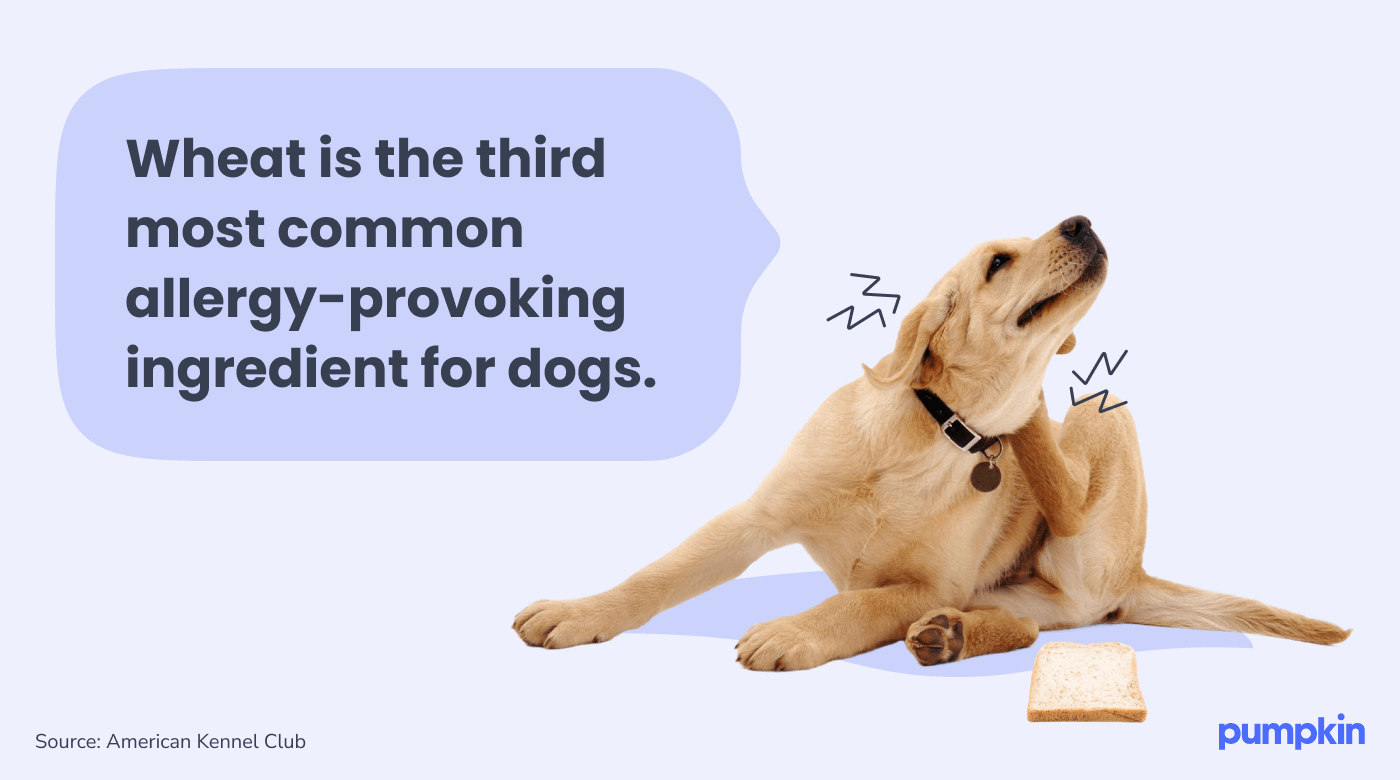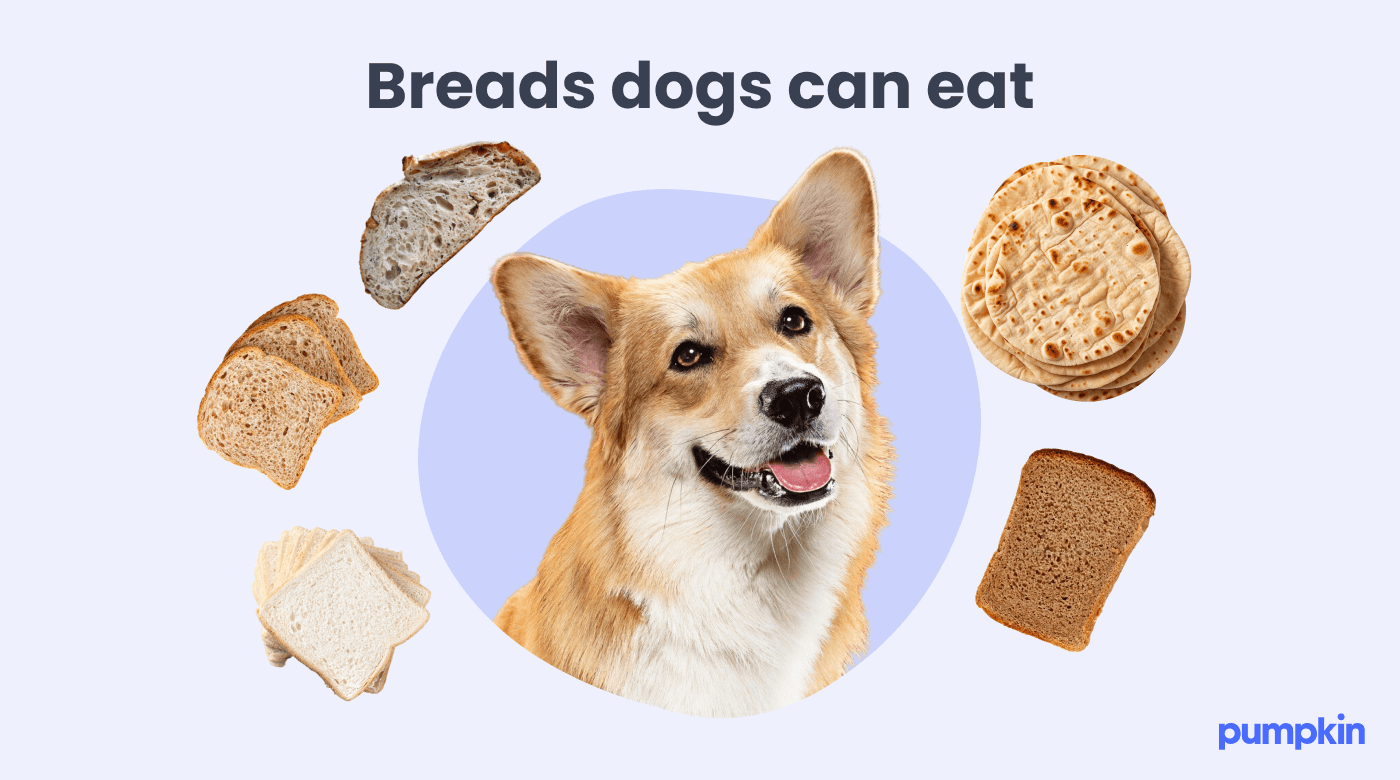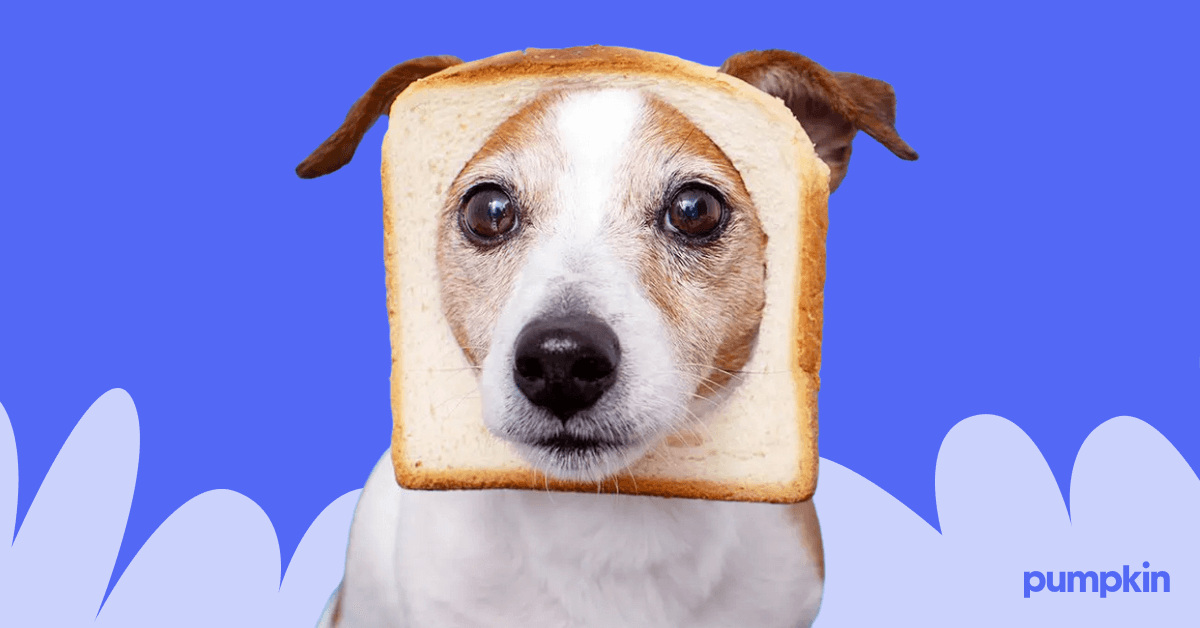Key Points:
- Yes, dogs can eat bread, provided it’s plain and served in small quantities.
- Dogs should not consume bread dough or bread with toxic ingredients like garlic or raisins.
- Too much bread can lead to obesity and other health issues in dogs.
As any dog parent knows, our pups aren’t exactly picky eaters. If you give them a slice of bread, they’ll happily snap it up, then run to savor their treat in the privacy of another room. But since dogs don’t stop to ponder if their snack is nutritious or safe for them to eat, we have to do it for them.
So the next time you have leftover bread scraps, can you give them to your pooch?
The quick answer is: Yes, dogs can eat bread as long as it’s plain, fully cooked, and contains no harmful added ingredients.
That being said, bread can be very toxic for your dog in certain situations. Let’s dive into all the information you need to keep your dog safe.
The nutritional value of bread for dogs
Bread has almost no nutritional value that your pup can’t get through their everyday food.
One slice of commercially prepared whole wheat bread offers:
- Calories: 81.5
- Protein: 3.95g
- Fat: 1.14g
- Carbohydrates: 13.8g
- Fiber: 1.93g
- Sugar: 1.42g
- Starch: 9.21g
- Sodium: 144mg
- Calcium: 52.3mg
- Potassium: 80.2mg
The fiber in whole-wheat bread can help the digestive tract keep everything moving. It binds with water and adds bulk to the stool, making it easier to pass. However, there are more nutritious snacks that have even more fiber.
What about nutrients? While bread does have some healthy nutrients (whole wheat bread contains trace amounts of zinc, iron, and magnesium), it doesn’t have more than your pup’s dog food. Use bread as a treat rather than a meal replacement.
A surprising benefit of bread for dogs
Bread is a popular home remedy for one of the most common pet accidents — a swallowed chicken bone. This staple food can help your dog digest small sharp bits of bone or other indigestible objects if they’ve accidentally swallowed them. Bread binds to the object, enabling it to pass through the digestive tract. However, this trick won’t always work, so check with your veterinarian for advice on using bread in this way.
The risks of feeding bread to dogs
Vets don’t consider most bread toxic to dogs. The trouble for your pooch lies in the ingredients, toppings, form, and amount in which it’s consumed.
Be aware of the following risks of feeding bread to your pooch.
Weight gain
Bread is a high-carbohydrate food (as carb lovers know all too well). Carbs turn to sugar (energy) in the body, and an excess of carbs in the diet can cause weight gain in your pup. Ensure that you feed your dog a balanced diet and give them enough exercise to avoid obesity. Remember: Keep bread as an occasional treat.
Wheat allergies
Wheat is among the most common food allergies in dogs. Some dogs can have an allergic reaction to wheat, although vets consider wheat bread to be a healthier option for most dogs.
Signs of a food allergy in your pup include:
- Itchy skin, paws, or ears
- Excessive gas
- Vomiting
- Diarrhea
- Weight loss
- Lack of energy
If your dog is allergic to wheat, you can offer them bread made with rice or coconut flour instead.

Dental disease
The sugars in bread can wreak havoc on your dog’s teeth because they adhere to the teeth and gums. The sugars attract bacteria to the teeth, causing plaque and dental calculus, which can lead to periodontal disease. Studies show that most dogs have dental disease by the age of three.
Certain types of bread can harm your pup
While most bread is not harmful to your dog, some types of bread have toxic ingredients that can definitely make your pup sick.
Unfortunately, some of our favorite bread products contain dangerous ingredients. Case in point: Everything bagels.
Avoid offering these types of slices to your dog:
- Banana bread
- Raisin bread
- Bread with nuts
- Garlic bread
- Bread with onions
- Chocolate bread
- Bread with artificial sweeteners
- Bread with nutmeg
The dangers of bread dough
Most of the ingredients in bread dough may be harmless, but yeast is not.
Your dog’s stomach contains the perfect set-up for yeast to activate, which means the dough will expand just as it would sitting out in your kitchen. This can lead to Bread Dough Toxicosis or bloat.
As the dough mass expands, it distends your dog’s stomach. This can cause vascular distention and compromise the blood supply in the walls of the stomach. This condition also causes respiratory problems.
While this distention is happening, your dog’s stomach will also create ethanol. Ethanol in the stomach is alcohol, and we call this condition ethanol or alcohol toxicosis.
Symptoms of ethanol toxicosis include:
- Extended or bloated stomach with gassiness or unproductive vomiting
- Loss of bladder control and coordination
- Behavior changes, such as random barking or strange vocalizations
- Weakness
- Seizures
- Coma
Because of this, it’s a medical emergency when a dog ingests bread dough. Your dog could show symptoms within 30 minutes, but they can take up to two hours to appear. If your dog’s ethanol level keeps rising, cardiac arrest can occur. See your vet right away if your dog ate bread dough containing yeast.
Accidental ingestion is a common pet insurance claim — and if your dog consumes something harmful, it’s important to have a pet insurance plan you trust to get you through pricey vet visits. Learn more about how Pumpkin’s pet insurance plans can help you afford individualized care for eligible vet care in the future.
How to prepare bread for dogs
As with all treats, offer your pooch bread in small amounts and in moderation. The calories your pup gets from treats shouldn’t make up more than 10% of the calories in their daily diet.
Avoid feeding them loaves with lots of butter, salt, or sugar. These ingredients aren’t good for your dog either.
The best types of bread for your pup are:
- Plain white bread
- Plain wheat bread
- Plain fully baked sourdough
- Rye bread
- Pita bread
It’s also generally okay to give your dog toasted bread, as long as you stick to the same guidelines (like offering plain slices with no harmful ingredients or added butter).
As with any new food you introduce to your pup, monitor their reaction the first time you give it to them.

Can puppies eat bread?
Weaned puppies can eat bread if you follow the same guidelines for adult dogs. It should only be offered as a treat without exceeding 10% of their daily diet. This means you’ll want to give your puppy bread in even smaller amounts since their stomachs can’t handle as much food as a full-grown pooch.
Bread is a safe snack
Sharing the crust of your toast or a piece of your sandwich bread won’t hurt your dog. Just be aware that bread is a human food with little to no nutritional value for your pup’s balanced diet. Offering it as an occasional treat is fine. Just remember that anything more than a small amount can affect your dog’s overall health in time. Most importantly, keep yeasty bread dough far away from your dog’s reach.
Pet Pro Tip: If you have a dog that is prone to ‘snacksidents’ – you should consider getting a dog insurance plan as soon as possible. It can help you afford the best care in the future by covering eligible vet bills for digestive illnesses, toxic ingestion, and more.
FAQs: Bread and dogs
- https://fdc.nal.usda.gov/fdc-app.html#/food-details/335240/nutrients
- https://www.akc.org/expert-advice/health/what-to-do-dog-eats-chicken-bone/
- https://www.akc.org/expert-advice/nutrition/can-dogs-eat-wheat/
- https://pubmed.ncbi.nlm.nih.gov/26753610/
- https://www.merckvetmanual.com/toxicology/food-hazards/bread-dough-toxicosis-in-animals
- https://todaysveterinarypractice.com/practical-toxicologyethanol-toxicosis-review/
- https://www.akc.org/expert-advice/nutrition/how-many-treats-can-dog-have/




